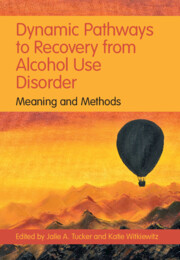Book contents
- Dynamic Pathways to Recovery from Alcohol Use Disorder
- Dynamic Pathways to Recovery from Alcohol Use Disorder
- Copyright page
- Dedication
- Contents
- Figures
- Tables
- Contributors
- Foreword
- Preface
- Acknowledgments
- Introduction
- Part I Micro Level
- Part II Meso Level
- 9 Natural Recovery from Alcohol Use Disorder
- 10 Individual Behavioral Interventions to Incentivize Sobriety and Enrich the Natural Environment with Appealing Alternatives to Drinking
- 11 Family and Social Processes in Recovery from Alcohol Use Disorder
- 12 Community-Based Harm Reduction Approaches for Alcohol Use Disorder
- 13 Use of Mobile Technology to Understand and Improve Recovery from Alcohol Use Disorder
- 14 Studying Recovery in the Social Context
- 15 Measuring Substance Use Contexts and Substance-Free Reinforcement
- Part III Macro Level
- Conclusions and Future Directions
- Index
- References
10 - Individual Behavioral Interventions to Incentivize Sobriety and Enrich the Natural Environment with Appealing Alternatives to Drinking
from Part II - Meso Level
Published online by Cambridge University Press: 23 December 2021
- Dynamic Pathways to Recovery from Alcohol Use Disorder
- Dynamic Pathways to Recovery from Alcohol Use Disorder
- Copyright page
- Dedication
- Contents
- Figures
- Tables
- Contributors
- Foreword
- Preface
- Acknowledgments
- Introduction
- Part I Micro Level
- Part II Meso Level
- 9 Natural Recovery from Alcohol Use Disorder
- 10 Individual Behavioral Interventions to Incentivize Sobriety and Enrich the Natural Environment with Appealing Alternatives to Drinking
- 11 Family and Social Processes in Recovery from Alcohol Use Disorder
- 12 Community-Based Harm Reduction Approaches for Alcohol Use Disorder
- 13 Use of Mobile Technology to Understand and Improve Recovery from Alcohol Use Disorder
- 14 Studying Recovery in the Social Context
- 15 Measuring Substance Use Contexts and Substance-Free Reinforcement
- Part III Macro Level
- Conclusions and Future Directions
- Index
- References
Summary
For many people with alcohol use disorder, meaningful improvement in quality of life, and in some cases mere survival, is predicated on reducing or eliminating drinking. As a result, this is often an immediate treatment target. However, the requirement to reduce alcohol use prior to enriching other life domains may inadvertently undermine both treatment efficacy and treatment seeking. This chapter first summarizes theoretical and empirical support for alcohol treatments that emphasize the broader goal of “building a life worth living” versus the narrow goal of reducing alcohol use. Behavioral economic research is reviewed that provides robust support for reducing drinking by increasing the availability of alcohol-free sources of reward, followed by a review of brief low threshold and more comprehensive alcohol treatments that include a focus on enhancing alternatives to alcohol. The chapter concludes with a discussion of the importance of disseminating these interventions to high-risk and underserved populations.
Keywords
- Type
- Chapter
- Information
- Dynamic Pathways to Recovery from Alcohol Use DisorderMeaning and Methods, pp. 179 - 199Publisher: Cambridge University PressPrint publication year: 2022



